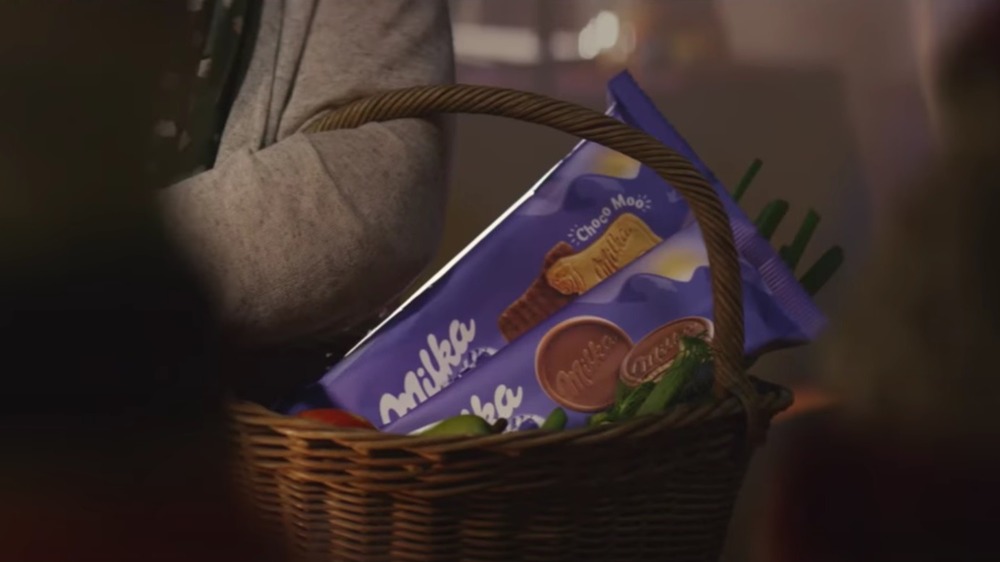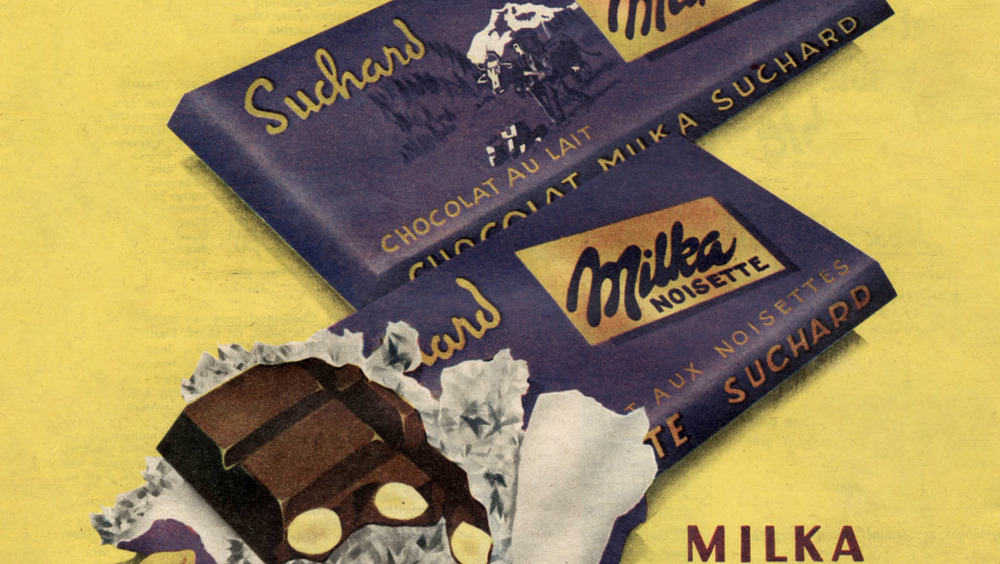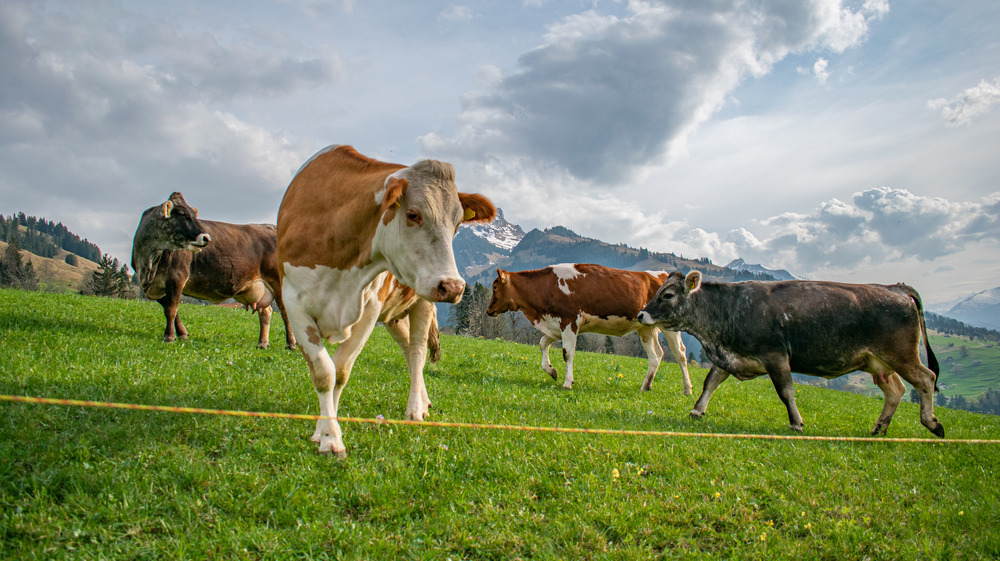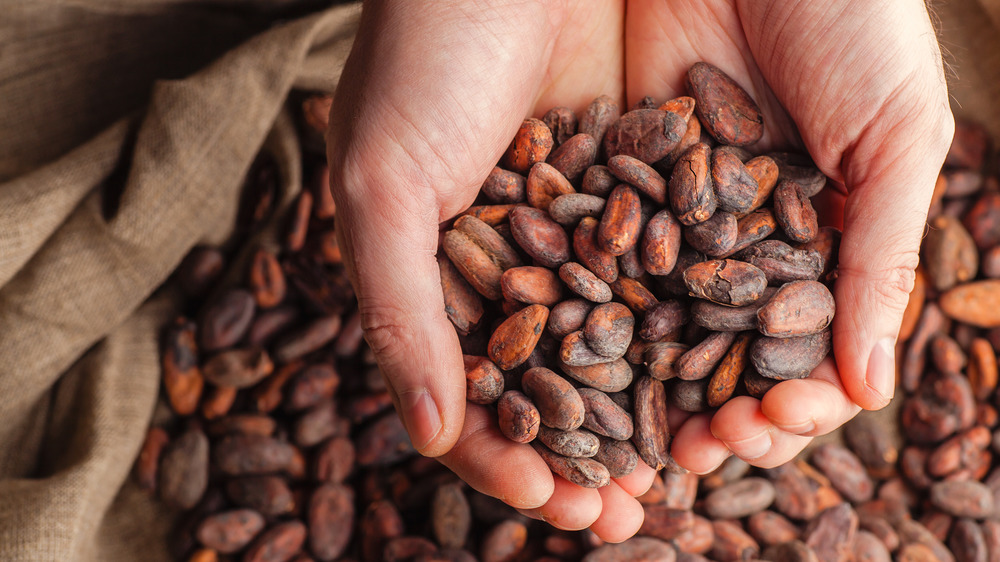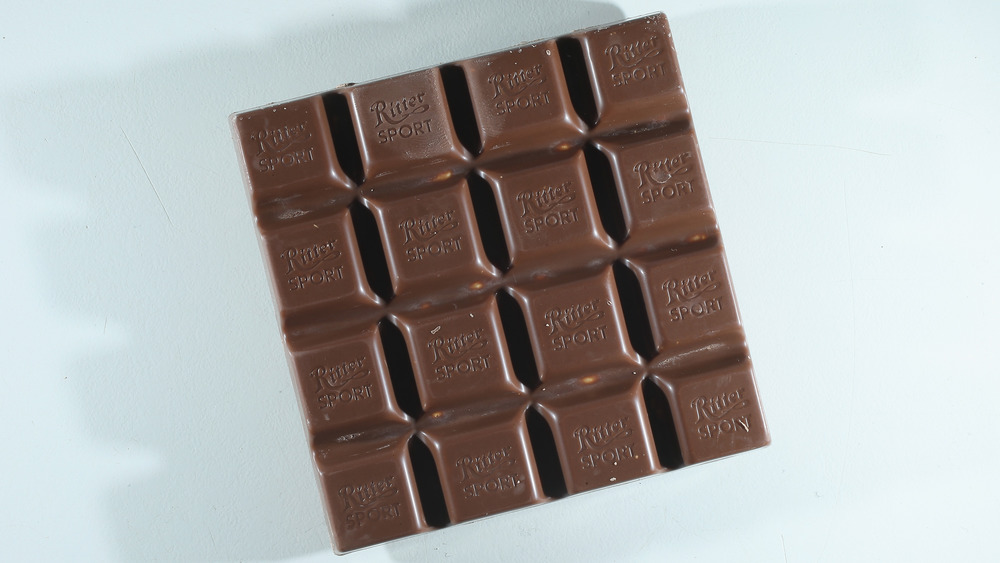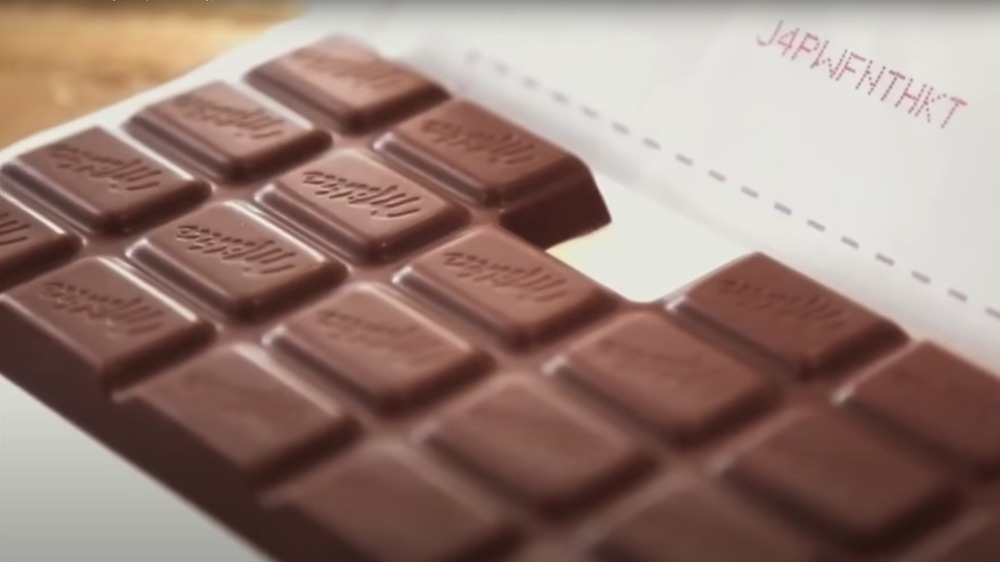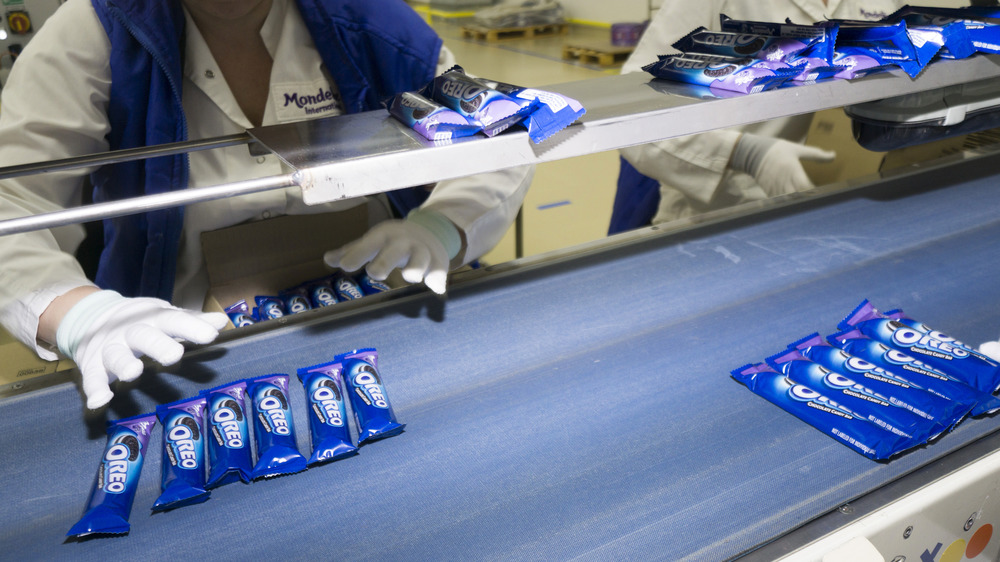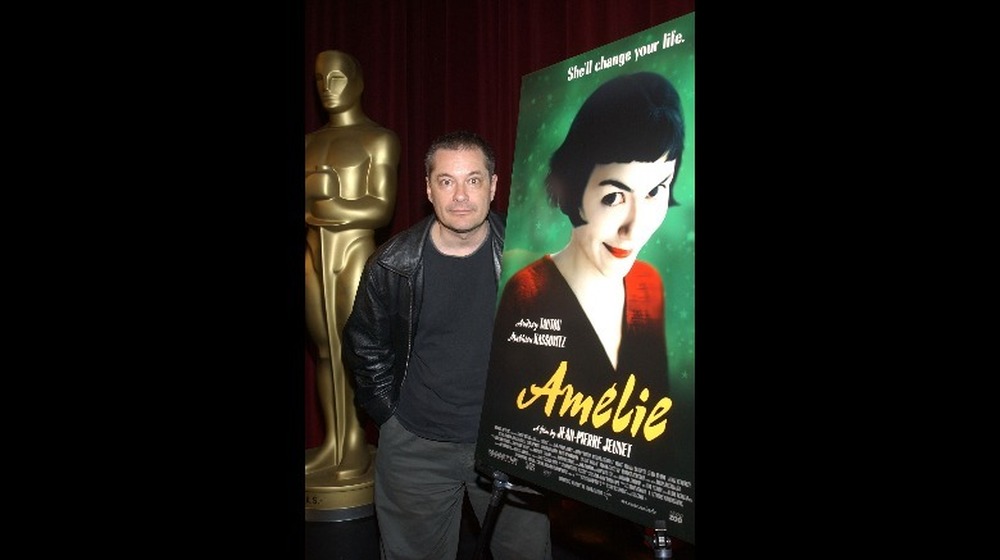The Untold Truth Of Milka Chocolate
We may receive a commission on purchases made from links.
Milka has held its reputation as a favorite European chocolate brand since the 1900s. If you are a post-millennial who loves Milka, there's a good chance that your great grandmother did, too. Over the years, the chocolate brand has become synonymous with the color purple and a purple spotted cow, thanks to the extensive marketing campaigns that the brand has been known for since its beginning. It's reported that even in the early 20th century, "vehicles and facades were also used for advertising purposes, as was the artistically designed packaging, posters, postcards and collector's pictures, which were extremely elaborate for the time" (via Suchard).
From its start in an abandoned mill, to becoming a billion dollar brand under Mondelēz International, Milka has expanded while still staying true to its roots. All the milk that is used for making Milka chocolates worldwide comes from a herd of 60 cows, all reared in farms that are within a 60-mile radius of each other in the Swiss Alps.
Besides its creamy, chocolaty treats, Milka serves up a case study of the evolution of chocolate itself. How powdered cocoa came to be a delightful snack is a story that Milka has had a significant role to play in. It's a story that is powdered with little-known facts — served best with a bag of Milka popcorn.
Milka has been in the market for over a century
Let's rewind to 1901 when the first Milka bar was produced in a factory in Germany. All credit goes to a certain Swiss chocolatier named Philippe Suchard whose love of chocolate pushed him to produce the little treats on a large scale.
Before that in 1825, Philippe Suchard founded a chocolate factory in Neuchâtel, Switzerland and named it after himself, Suchard (via Suchard). By 1880, Suchard expanded to Germany, establishing its first international presence.
Suchard grew to an entirely new level, becoming the top milk chocolate brand in Germany, but the man who was at the helm of it all wouldn't be alive to see the sweet success. Philippe Suchard passed away in 1884, leaving the factory to his son-in-law Carl Russ. It was under Russ' leadership that Suchard produced its first milk chocolate, Milka — a name that combines German words milch (milk) and kakao (cocoa). Since then, Milka has come a long way, with its presence now in over 40 countries.
The oldest Milka chocolate factory is in Lörrach, Germany
If you look at Google maps, the town of Lörrach almost grazes the Switzerland border. Swiss chocolatier Philippe Suchard established his second factory in this German town in 1880 (the first was in his home country Switzerland). The first batch of Milka chocolates were produced just as the world entered the 20th century. This factory, where it all started, still has 500 employees working around the clock. Suchard opened another factory in 1887 in Bludenz, Austria.
According to the book Swiss Made: The Untold Story Behind Switzerland's Success, around the time Suchard started production of Milka, "There was fierce competition, initially from a number of Dutch and British companies." This included the well-established ones such as England-based Cadbury and Amsterdam-based Van Houten.
Suchard thrived in this war of chocolate brands. "After the First World War, when exports were hindered by the reimposition of high tariffs and currency restrictions, the company opened chocolate factories in the US, the UK, Argentina, Sweden, and South Africa" (via Swiss Made: The Untold Story Behind Switzerland's Success).
Milka is made with Alpine milk
Milka chocolates are made with three ingredients: cocoa beans, sugar, and milk that's 100 percent Alpine. Unlike Cadbury or Hershey, which use fresh milk, Milka makes its chocolates with powdered milk.
According to Science Direct, "Milk powder, as a commercial product, can be traced to as early as 1868." In the late 1800s, the chocolate legend Henri Nestlé had developed a powdered milk product, which inspired his friend Daniel Peter to invent the milk chocolate we know and love today (via Swissinfo.ch).
While the sweet milk cocoa combo took over the world in the early 20th century, the Suchard company, Milka's creator, developed its unique selling point: the use of 100 percent powdered Alpine milk. The fact that they only use milk from the cows that are fed on Alpine grass is of great significance. According to the National Library of Medicine, this milk is healthier than other varieties of milk. Milka takes pride in this ingredient, so much so that for a limited time, it featured select cows from its farms — Moocha, Gerda, Katja, Marisa, and Lola — on Milka's wrappers.
Milka's mascot is a purple cow named Lila
Milka chocolate bars have always featured a dairy farmer, a cow, and the Alps on their wrapper — right from the year they were introduced in 1901. As years passed, the farmer was dropped out, and the cow became more and more prominent. By the late '90s, the cow even had a golden bell around its neck. The cow was introduced as Lila in print and television advertisements in the 1970s. By 1972, the purple-spotted cow had been featured in over 100 television ads.
Lila means lilac in German. It's a color that the brand has grown to be associated with. Given how important Lila became for the image of the chocolate, fast-forward to 2012, and Milka went the extra mile to celebrate the birth of a "purple calf" in a small village of Serbia (via Branding Mag). The calf was showered with Milka gifts and a soft Milka shawl.
Milka switched many hands before being owned by U.S.-based Mondelēz International
Mondelēz International owns so many delicious brands, including OREO, Cadbury, Chips Ahoy, and Milka. So how did Milka, a Swiss chocolate brand, come to be owned by an Illinois-based organization?
Seven years after Milka was launched by Suchard in Germany, a certain triangular-shaped bar with almonds and nougat hit the market in 1908. Toblerone creator, Tobler, and Milka's parent company, Suchard, joined forces in 1970 to become Interfood. In 1982, a German entrepreneur Klaus J. Jacobs of Johann Jacobs & Co came along, and bought Suchard and Tobler brands. Milka was now part of Jacobs Suchard.
The company ran for eight years before Jacobs sold it to U.S.-based Philip Morris for "3.1 billion Swiss francs ($2.2 billion at the time)" in 1990 (via Forbes). Philip Morris was originally a tobacco producer, but had become the world's largest consumer goods company by the '90s after acquiring Kraft Inc. and General Foods Corp (via Chicago Tribune). So, as part of the billion-dollar deal, Suchard became part of Kraft Foods Inc. — a combination of Kraft Inc. and General Foods (via abc News).
The business was so massive that in 2012, Kraft Foods Inc. broke off into separate companies: Kraft Foods Group dealt with the grocery business, and Kraft Foods Inc., which is now Mondelēz International, was responsible for everything else — and this included the Milka brand (via Food Industry).
Cocoa used in Milka is sustainably sourced
Cocoa plantations have been a leading cause of deforestation in countries such as Ivory Coast and Ghana. According to a February 2019 article via Yale Environment 360, which was published at the Yale School of the Environment, over 80% of forests have sadly been lost in the Ivory Coast over the past 50 or so years. This was mostly attributed to the production of cocoa.
Acknowledging the effect that a bar of chocolate can have on climate change in the future, Milka joined the Cocoa Life program in 2018, which ensures sustainable sourcing of cocoa (via GlobeNewswire). The Cocoa Life program provides incentives to farmers to grow other tree varieties besides cocoa trees — a method that will help protect forest areas. Through the program, farmers will learn how to use less land to grow a greater amount of cocoa. And to ensure that this is done, Mondelēz Industries signed a Memoranda of Understanding with the Ghanaian and Côte d'Ivoire governments (via Cocoalife.org).
Milka fought and lost a 10-year legal battle with another chocolate brand
Just how Mika has a patent on the purple color on its wrapper, the brand's competitor, German-based Ritter Sport, has a patent on square-shaped bars.
According to BBC, Ritter Sport is reported to have introduced square-shaped bars for the convenience of slipping them inside jacket pockets. The company had the shape patented in 1993. While the rest of the chocolate companies were satisfied moulding their chocolate into rectangular bars, Milka decided to challenge Ritter Sport monopoly over square-shaped bars. Milka went ahead and introduced a square-shaped bar in 2010. This kickstarted a decade-long battle that had the two chocolate companies fighting over the shape.
In the Milka vs. Ritter Sport battle, Milka won the first round in court in 2016. But Ritter Sport had the last laugh. The court ruled in favor of Ritter Sport keeping its patent, saying, "Consumers considered the square nature of the chocolate bar as an indication of both where the chocolate came from and its quality, they concluded" (via BBC).
As part of a campaign, Milka bars were sold with one missing square
According Famous Campaigns, as part of a marketing campaign, Milka sold chocolate bars with one square missing. Consumers had the option of either taking the square for themselves or sending it to a loved one with a customized message.
The campaign encouraged their consumers to "dare to be tender." This kickstarted in France in 2013, and received a great response. Over half a million last squares were sent. It was a huge marketing success for Milka, bringing Mondelēz International over 1.3 million euros.
The campaign also expanded to Argentina in a different form. There, Milka set up a chocolate vending machine next to a life-size Milka cow. The machine spit out a chocolate when a person touched both the machine and the cow at the same time. The catch, however, was that the cow was remote controlled and kept moving further away, encouraging people to hold hands to form a chain, thus encouraging interaction among strangers (via becausexm.com).
A certain casting call for a Milka commercial sparked outrage
A casting call for a Milka chocolate advertisement in 2019 had the brand battling a PR catastrophe. Spotlight UK, the talent agency that had posted the casting call on their website, was called out for objectifying girls and being outright disrespectful. According to Pedestrian, the ad was shared on Twitter, and read, "She must be beautiful and angelic." It went on to elaborate, "Eye colour and hair colour are not important but no red hair [...] she must NOT have reached puberty." Furthermore, it included, "No overweight children as this is advertising chocolate" (via Pedestrian).
Shared by Scottish actor Helen Raw on Twitter, the ad got a flood of reaction from those who found the phrasing absolutely cringeworthy, just as Raw did. Spotlight acknowledged their mistake, and updated the write-up several times. Eventually, they posted a public apology.
According to Independent, Milka and its parent company Mondelēz International had no idea about the ad until it was shared on Twitter by Raw. They took to Twitter to thank Raw for bringing the ad to their attention: "This is not representative of the brief we shared with the casting agency and we are urgently reviewing the situation" (via Independent).
Milka has been sponsoring ski championships since 1995
Cows may not be the most athletic animals out there, but they have become a common sight at skiing events around the world, thanks to Milka and its marketing team. "Today there is hardly a Ski World Cup or Ski World Championship race without Milka branding in various forms," according to Milka's official website. It started in 1995 when Milka sponsored the FIS Alpine Cup in Lienz. As a sponsor, they set up a life-size inflated purple Milka cow.
Since then, Milka has been associated with skiing events while also sponsoring individual athletes such as Austrian Michaela Kirchgasser, Czech athlete Sarka Strachova, Olympic gold medalist Anna Fenninger, among others (via Ski Racing).
There is more to Milka than chocolate bars
Soft cookies embedded with Milka chocolate bits, Milka chocolate wafers ... the options are mind boggling. And just when we thought we had all the delicious options, Milka's partnership with Oreo in 2016 had us walking the supermarket aisles for the heavenly cookie-chocolate combo. The Milka OREO Big Crunch Chocolate Candy Bar and the Milka OREO Chocolate Candy Bar are a couple of the options that the marriage between the two strong brands brought out for chocolate lovers (via PR Newswire).
Milka has also collaborated with Daim to bring out bars with a little almond caramel crunch, and Philadelphia to introduce a chocolate and cream cheese spread. Even as Milka seems to be slowly expanding its arena, the brand knows that with power comes responsibility. The brand is committed to take the issues of sustainability and health seriously. In 2019, Mondelēz International, which owns Milka, joined hands with TerraCycle to kickstart a subscription-based model for some of Milka's products with sustainable packaging so you can refill it.
Jean-Pierre Jeunet directed a Milka ad
Milka adopted "tenderness" as its marketing theme in the 1960s. Almost half a century later, the brand still seems to stand by it, creating movies that melt hearts like chocolate bars under the sun. Take, for example, the doll-like characters in its 2020 stop-motion ad film Goodness, or the story of an innocent young girl who tries to save her father's job in Lost and Found.
Wieden+Kennedy, the agency behind Milka's ads, even managed to rope in the popular French movie director Jean-Pierre Jeunet to create a 90-second commercial ad for Milka for Christmas 2016 (via Little Black Book). The film, called The Time Machine, is about a boy who builds a time machine to fast-forward to the days leading to Christmas. As an ode to Lila, Milka's iconic purple cow, the film is set in a fictional town called Lilaberg. "It's actually one of my favourite ads I've ever made," said Jeunet.
